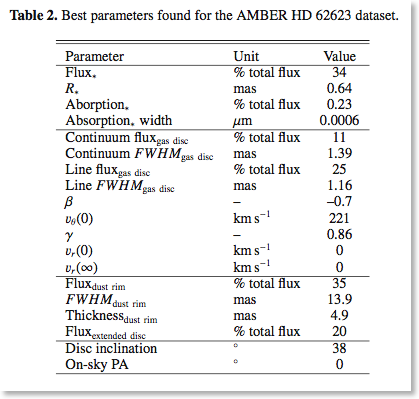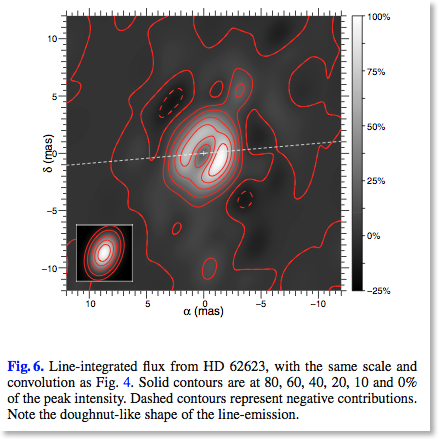by A. Meilland, S. Kanaan, M. Borges Fernandes, O. Chesneau, F. Millour, Ph. Stee, and B. Lopez 2010, A&A, 512, 73
B[e] stars are hot stars surrounded by circumstellar gas and dust responsible for the presence of emission lines and IR-excess in their spectra. How dust can be formed in this highly illuminated and diluted environment remains an open issue.
HD 62623 is one of the very few A-type supergiants showing the B[e] phenomenon. We studied the geometry of its circumstellar envelope in the mid-infrared using long-baseline interferometry, which is the only observing technique able to spatially resolve objects smaller than a few tens of milliarcseconds.
We obtained nine calibrated visibility measurements between October 2006 and January 2008 using the VLTI/MIDI instrument in SCI-PHOT mode and PRISM spectral dispersion mode with projected baselines ranging from 13 to 71 m and with various position angles (PA). We used geometrical models and physical modeling with a radiative transfer code to analyze these data.
The dusty circumstellar environment of HD 62623 is partially resolved by the VLTI/MIDI even with the shortest baselines. The environment is flattened (a/b∼1.3±0.1) and can be separated into two components: a compact one whose extension grows from 17 mas at 8µm to 30 mas at 9.6µm and stays almost constant up to 13µm, and a more extended one that is over-resolved even with the shortest baselines. Using the radiative transfer code MC3D, we managed to model HD 62623’s circumstellar environment as a dusty disk with an inner radius of 3.85±0.6 AU, an inclination angle of 60±10°, and a mass of 2.10−7 M_sun.
It is the first time that the dusty disk inner rim of a supergiant star exhibiting the B[e] phenomenon is significantly constrained. The inner gaseous envelope likely contributes up to 20% to the total N band flux and acts like a reprocessing disk. Finally, the hypothesis of a stellar wind deceleration by the companion’s gravitational effects remains the most probable case since the bi-stability mechanism does not seem to be efficient for this star.









Imaging the spinning gas and dust in the disc around the supergiant A[e] star HD 62623
by F. Millour, A. Meilland, O. Chesneau, Ph. Stee, S. Kanaan, R. Petrov, D. Mourard and S. Kraus 2011, A&A, 526, A107
To progress in the understanding of evolution of massive stars one needs to constrain the mass-loss and determine the phenomenon responsible for the ejection of matter an its reorganization in the circumstellar environment
In order to test various mass-ejection processes, we probed the geometry and kinematics of the dust and gas surrounding the A[e] supergiant HD 62623.
We used the combined high spectral and spatial resolution offered by the VLTI/AMBER instrument. Thanks to a new multi-wavelength optical/IR interferometry imaging technique, we reconstructed the first velocity-resolved images with a milliarcsecond resolution in the infrared domain.
We managed to disentangle the dust and gas emission in the HD 62623 circumstellar disc. We measured the dusty disc inner rim, i.e. 6 mas, constrained the inclination angle and the position angle of the major-axis of the disc. We also measured the inner gaseous disc extension (2 mas) and probed its velocity field thanks to AMBER high spectral resolution. We find that the expansion velocity is negligible, and that Keplerian rotation is a favoured velocity field. Such a velocity field is unexpected if fast rotation of the central star alone is the main mechanism of matter ejection.
As the star itself seems to rotate below its breakup-up velocity, rotation cannot explain the formation of the dense equatorial disc. Moreover, as the expansion velocity is negligible, radiatively driven wind is also not a suitable explanation to explain the disc formation. Consequently, the most probable hypothesis is that the accumulation of matter in the equatorial plane is due to the presence of the spectroscopic low mass companion.






The press releases can be browsed by following these links:
- CNRS (French) http://www2.cnrs.fr/presse/communique/2088.htm
- Max-Planck (English) http://www.mpg.de/1054436/Supergiant_star_imaging
- Max-Planck (German)http://www.mpg.de/1051794/Riesenstern_Staubscheibe
- ESO (English) http://www.eso.org/public/announcements/ann11002/